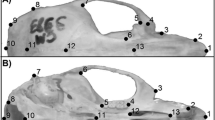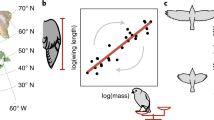Abstract
Geographical variation in morphometric characters in heteromyid rodents has often correlated with climate gradients. Here, we used the long-term database of rodents trapped in the Sevilleta National Wildlife Refuge in New Mexico, USA to test whether significant annual changes in external morphometric characters are observed in a region with large variations in temperature and precipitation. We looked at the relationships between multiple temperature and precipitation variables and a number of morphological traits (body mass, body, tail, hind leg, and ear length) for two heteromyid rodents, Dipodomys merriami and Perognathus flavescens. Because these rodents can live multiple years in the wild, the climate variables for the year of the capture and the previous 2 years were included in the analyses. Using multiple linear regressions, we found that all of our morphometric traits, with the exception of tail length in D. merriami, had a significant relationship with one or more of the climate variables used. Our results demonstrate that effects of climate change on morphological traits occur over short periods, even in noninsular mammal populations. It is unclear, though, whether these changes are the result of morphological plasticity or natural selection.
Similar content being viewed by others
References
Agrawal AA (2001) Ecology–phenotypic plasticity in the interactions and evolution of species. Science 294:321–326, doi:10.1126/science.1060701
Avise JC (2000) Phylogeography. Harvard University Press, Cambridge, Massachusetts
Baumgardner GD, Kennedy ML (1993) Morphometric variation in kangaroo rats (genus Dipodomys) and its relationship to selected abiotic variables. J Mammal 74:69–85, doi:10.2307/1382252
Best TL (1993) Patterns of morphological and morphometric variation in heteromyid rodents. In: Genoways H, Brown J (eds) Biology of the heteromyidae. Special publication No. 10. The American Society of Mammalogists, Provo, Utah, pp 197–235
Borges RM (2005) Do plants and animals differ in phenotypic plasticity. J Biosci 30:41–50, http://www.ias.ac.in/jbiosci/feb2005/41.pdf
Burnham KP, Anderson DR (1998) Model selection and inference. Springer Verlag
Cheverud JM (1982) Phenotypic, genetic, and environmental morphological integration in the cranium. Evolution 36:499–516, doi:10.2307/2408096
Del Valle JC, Busch C, Mananes AAL (2006) Phenotypic plasticity in response to low quality diet in the South American omnivorous rodent Akodon azarae (Rodentia: Sigmodontinae). Comp Biochem Physiol A: Mol Integr Physiol 145:397–405, doi:10.1016/j.cbpb.2004.10.013
French NR, Maza B, Aschwanden AP (1967) Life spans of Dipodomys and Perognathus in the Mojave Desert. J Mammal 48:537–548
Koontz TL, Shepherd UL Marshall D (2001) The effects of climate change on Merriam’s kangaroo rat, Dipodomys merriami. J. Arid Environ. 49:581–591, doi:10.1006/jare.2001.0806
Lidicker WZ (1960) An analysis of intraspecific variation in the kangaroo rat Dipodomys merriami. Univ Calif Publ Zool 67:125–218
Losos JB, Creer DA, Glossip D, Goellner R, Hampton A, Roberts G, Haskell N, Taylor P, Ettling J (2000) Evolutionary implications of phenotypic plasticity in the hindlimb of the lizard Anolis sagrei. Evolution 54:301–305, doi:10.1554/0014-3820(2000)054[0301:EIOPPI]2.0.CO;2
Millien V, Lyons SK, Olson L, Smith FA, Wilson T, Yom-Tov Y (2006) Ecotypic variation in the context of global climate change: revisiting the rules. Ecol Lett 9:853–869, doi:10.1111/j.1461-0248.2006.00928.x
Mohr E (1941) Schwanzverlust und Schwanzregeneration Nagetieren Zool Anz 135:49–65
Monk RR, Jones JK Jr (1996) Perognathus flavescens. Mammal Spec 525:1–4
Muldavin E, Shore G, Taugher K, Milne B (1998) A vegetation classification and map for the sevilleta national wildlife refuge, New Mexico: Final Report. Biology Department: New Mexico Natural Heritage Program and the Sevilleta LTER Program. A final report to The Nature Conservancy (New Mexico Chapter), the Mary Flagler Cary Charitable Trust, the Sevilleta National Wildlife Refuge, the New Mexico Natural Heritage Program, and the Sevilleta Long Term Ecological Research Program [SEV Pub. No. 213]
Parmenter RR, Yates TL, Anderson DR, Burnham KP, Dunnum JL, Franklin AB, Friggens MT, Lubow BC, Miller M, Olson GS, Parmenter CA, Pollard J, Rexstad E, Shenk TM, Stanley TR, White GC (2003) Small-mammal density estimation: A field comparison of grid-based vs. web-based density estimators. Ecol Monogr 73:1–26
Parmesan C (2006) Ecological and evolutionary responses to recent climate change. Annu Rev Ecol Evol Syst 37:637–669, doi:10.1146/annurev.ecolsys.37.091305.110100
Pergams ORW, Ashley MV (2001) Microevolution in island rodents. Genetica 112–113 245–256. (doi:10.1023/A:1013343923155)
Pestano J, Brown RP (1999) Geographical structuring of mitochondrial DNA in Chalcides sexlineatus within the island of Gran Canaria. Proc R Soc Lond B Biol Sci 266:805–812, doi:10.1098/rspb.1999.0709
Polly PD (2004) On the simulation of the evolution of morphological shape: multivariate shape under selection and drift. Palaeontol Electron 7.2.7A: 28pp 2.3MB. http://palaeo-electronica.org/2004_2/evo/issue2_04.htm
Post E, Langvatn R, Forchhammer MC, Stenseth NC (1999) Environmental variation shapes sexual dimorphism in red deer. Proc Natl Acad Sci USA 96:4467–4471
Renaud S, Michaux JR (2007) Mandibles and molars of the wood mouse, Apodemus sylvaticus (L.): integrated latitudinal pattern and mosaic insular evolution. J Biogeogr 34:339–355
Schnell GD, Best TL, Kennedy ML (1978) Interspecific morphologic variation in kangaroo rats (Dipodomys): degree of concordance with genic variation. Syst Zool 27:34–48, doi:10.2307/2412811
Shargal E, Rath L, Kronfeld N, Dayan T (1999) Ecological and histological aspects of tail loss in spiny mice (Rodentia: Muridae, Acomys) with a review of its occurrence in rodents. J Zool 249:187–193, doi:10.1017/S0952836999010080
Smith FA, Browning H, Shepherd UL (1998) The influence of climate change on the body mass of woodrats Neotoma in an arid region of New Mexico, USA. Ecography 21:140–148, doi:10.1006/jare.2001.0806
Snyder KA, Tartowski SL (2006) Multi-scale temporal variation in water availability: implications for vegetation dynamics in arid and semi-arid ecosystems. J Arid Environ 65:219–234, doi:10.1016/j.jaridenv.2005.06.023
Starck JM (1999) Structural flexibility of the gastro-intestinal tract of vertebrates—implications for evolutionary morphology. Zool Anz 238:87–101
Stearns SC (1989) The evolutionary significance of phenotypic plasticity. Bioscience 39:436–445, doi:10.2307/1311135
Storz JF, Balasingh J, Bhat HR, Nathan PT, Doss DPS, Prakash AA, Kunz TH (2001) Clinal variation in body size and sexual dimorphism in an Indian fruit bat, Cynopterus sphinx (Chiroptera: Pteropodidae). Biol J Linn Soc 72:17–31
Sullivan RM, Best TL (1997) Systematics and morphologic variation in two chromosomal forms of the agile kangaroo rat (Dipodomys agilis). J Mammal 78:775–797, doi:10.2307/1382936
Sumner FB, Collins HH (1918) Autotomy of the tail in rodents. Biol Bull 34:1–6, doi:10.2307/1536244
Thorpe RS (1996) The use of DNA divergence to help determine the correlates of evolution of morphological characters. Evolution 50:524–531, doi:10.2307/2410828
West-Eberhard M-J (2003) Developmental plasticity and evolution. Oxford University Press, Oxford, UK
Williams DF (1978) Systematics and ecogeographic variation of the Apache pocket mouse (Rodentia: Heteromyidae). Bull. Carnegie Mus. Nat. Hist No. 10
Wilson DE, Ruff S (1999) The Smithsonian Book of North American mammals Smithsonian Institution Press
Wojcik AM, Polly PD, Sikorski MD, Wojcik JM (2006) Selection in a cycling population: Differential response among skeletal traits. Evolution 60:1925–1935
Yates TL, Jones C, Cook JA (1996) Preservation of voucher specimens. Pp. 265–273 In: Wilson DE, Cole F, Nichols JD, Rudran R, & Foster M (eds) In measuring and monitoring biological diversity: standard methods for mammals. Smithsonian Institution Press, Washington, DC, pp 480
Yom-Tov Y, Geffen E (2006) Geographic variation in body size: the effects of ambient temperature and precipitation. Oecologia 148:213–218, doi:10.1007/s00442-006-0364-9
Yom-Tov Y, Yom-Tov S, Møller H (1999) Competition, coexistence, and adaptation amongst rodent invaders to Pacific and New Zealand islands. J Biogeogr 26:947–958, doi:10.1046/j.1365-2699.1999.00338.x
Yom-Tov Y, Heggberget TM, Wiig O, Yom-Tov S (2006) Body size changes among otters, Lutra lutra, in Norway: the possible effects of food availability and global warming. Oecologia 150:155–160, doi:10.1007/s00442-006-0499-8
Zar JH (1999) Biostatistical analysis, Fourth Edition. Prentice-Hall, Upper Saddle River, New Jersey, USA
Acknowledgements
We would like to thank the Sevilleta NWR staff, both present and past, for permission to use their Database, Dr. Michael Mares for useful comments and, of course, all those who did the actual hard work of collecting the data for the Sevilleta Database. We would also like thank our anonymous reviewers for constructive and helpful comments and suggestions.
Author information
Authors and Affiliations
Corresponding author
Rights and permissions
About this article
Cite this article
Wolf, M., Friggens, M. & Salazar-Bravo, J. Does weather shape rodents? Climate related changes in morphology of two heteromyid species. Naturwissenschaften 96, 93–101 (2009). https://doi.org/10.1007/s00114-008-0456-y
Received:
Revised:
Accepted:
Published:
Issue Date:
DOI: https://doi.org/10.1007/s00114-008-0456-y




